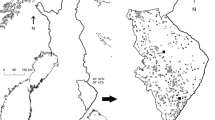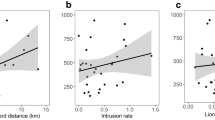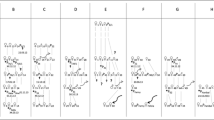Summary
-
1.
Three species of red-breasted meadowlarks (Aves, Icteridae, Sturnella) coexist on the pampas of southern Buenos Aires Province, Argentina. The species differ somewhat in size and shape but have very similar color patterns.
-
2.
In the nearly homogeneous habitat provided by wheat fields, S. defilippii and S. militaris superciliaris have nonoverlapping territories that are maintained by interspecific aggression and that are not related to vegetation discontinuity. Maintenance of interspecific territoriality (IST) was not mutual, for the larger species (defilippii) had a much stronger tendency to attack and exclude the smaller species than vice versa. However, once a superciliaris male did establish a territory, it was capable of defending it against defilippii males. A third species, S. loyca, had territories that overlapped those of the other two species, and although the largest of the three, it seldom engaged in interspecific aggression.
-
3.
The observed interspecific aggression seems due to close similarities in plumage and behavior of defilippii and superciliaris, reflecting their close phylogenetic relationship. No evidence has been adduced indicating how or whether the IST is adaptive, and no reason for predicting character convergence emerges from this study.
-
4.
This paper describes a method for quantifying the relative contribution of two or more species to interspecific aggression, including methods for correcting for the actual availability of heterospecific and conspecific males.
Similar content being viewed by others
References
Ashmole, N.P.: Competition and interspecific territoriality in Empidonax flycatchers. Syst. Zool. 17, 210–212 (1968)
Blake, E.R.: Icteridae. In: Check-list of birds of the world, Vol. 14. Mayr, E., Greenway, J. (eds.). Cambridge, MA: Harvard University 1968
Bock, W.: Evolution and phylogeny in morphologically similar groups. Am. Nat. 97, 265–285 (1963)
Cody, M.L.: Interspecific territoriality among hummingbrids. Condor 70, 270–271 (1968a)
Cody, M.L.: On the methods of resource division in grassland bird communities. Am. Nat. 102, 107–147 (1968b)
Cody, M.L.: Convergent characteristics in sympatric populations: A possible relation to interspecific territoriality. Condor 71, 222–239 (1969)
Cody, M.L.: Character convergence. Annu. Rev. Ecol. Syst. 4, 189–211 (1973)
Gochfeld, M.: Comparative ecology and behavior of red-breasted meadowlarks (Aves, Icteridae) and their interactions in sympatry. Unpubl. Ph.D. dissertation, City University of New York (1975)
Gochfeld, M.: Social facilitation of singing: Group size and flight song rates in the Pampas Meadowlark, Sturnella defilippii. Ibis 120, 338–339 (1978)
Grant, P.R.: Convergent and divergent character displacement. Biol. J. Linn. Soc. 4, 39–68 (1972)
Grant, P.R.: The classical case of character displacement. Evol. Biol. 8, 237–337 (1975)
Lanyon, W.E.: Territory in the meadowlarks, genus Sturnelld. Ibis 98, 485–489 (1956)
Lanyon, W.E.: The comparative biology of the meadowlarks (Sturnella) in Wisconsin. Nuttall Ornithol. Club 1, 1–67 (1957)
Lyon, D.L., Crandall, J., McKone, M.: A test of the adaptiveness of interspecific territoriality in the Blue-throated Hummingbird. Auk 94, 448–454 (1977)
Moynihan, M.: Social mimicry: Character convergence versus character displacement. Evolution 22, 315–331 (1968)
Murray, B.G., Jr.: The ecological consequence of interspecific territorial behavior in birds. Ecology 52, 414–423 (1971)
Murray, B.G., Jr.: A critique of interspecific territoriality and character convergence. Condor 78, 518–525 (1976)
Nice, M.M.: The role of territory in bird life. Am. Midl. Nat. 26, 441–487 (1941)
Orians, G.H., Willson, M.F.: Interspecific territories of birds. Ecology 45, 736–745 (1964)
Short, L.L.: Sympatry of Red-breasted Meadowlarks in Argentina, and the taxonomy of meadowlarks (Aves: Leistes, Pezites, and Sturnella). Am. Mus. Novit. No. 2349, 1–30 (1968)
Simmons, K.E.L.: Interspecific territorialism. Ibis 93, 407–413 (1951)
Sokal, R.R., Rohlf, J.F.: Biometry. San Francisco: Freeman 1969
Verner, J.: On the adaptive significance of territoriality. Am. Nat. 111, 769–775 (1977)
Wetmore, A.: Observations on the birds of Argentina, Paraguay, Uruguay, and Chile. US Natl. Mus. Bull. 133, 1–448 (1926)
Author information
Authors and Affiliations
Rights and permissions
About this article
Cite this article
Gochfeld, M. Interspecific territoriality in red-breasted meadowlarks and a method for estimating the mutuality of their participation. Behav Ecol Sociobiol 5, 159–170 (1979). https://doi.org/10.1007/BF00293303
Received:
Issue Date:
DOI: https://doi.org/10.1007/BF00293303




